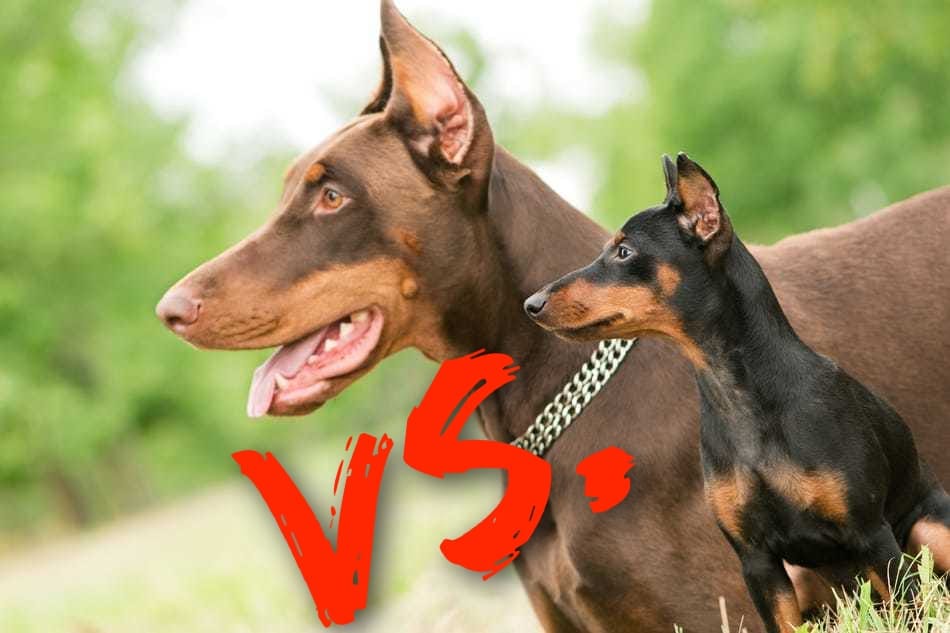
The Doberman Pinscher and the Miniature Pinscher sure look very similar. They’re often both black with similar tan markings, they both frequently have cropped ears and docked tails, and both have a similar toned muscular body. Obviously the Miniature Pinscher (or Min Pin) is very small compared to the Doberman, but other than size, what’s the difference?
What’s the difference between a Doberman and a Miniature Pinscher? The Doberman is 50 to 90 pounds heavier and 12 to 18 inches taller than the Miniature Pinscher. Also, the Doberman is a working dog related to the Rottweiler, German shepherd, and Greyhound. The Miniature Pinscher is a companion dog related to the Dachshund, Italian Greyhound, and German Pinscher.
The Doberman is very different from the Miniature Pinscher genetically, despite their similar appearance. These dogs are not considered by experts to be related. However, it is believed that they may share one ancestor in common—the German pinscher. However, there are a whole lot of differences between these two dogs other than size.
They behave differently, belong to different canine classes, and were bred for different purposes. After speaking to tons of owners who have both Min Pins and Dobermans, I wrote this article to cover the various differences between the two and I’ll also answer whether they can get along and live together in the same home.
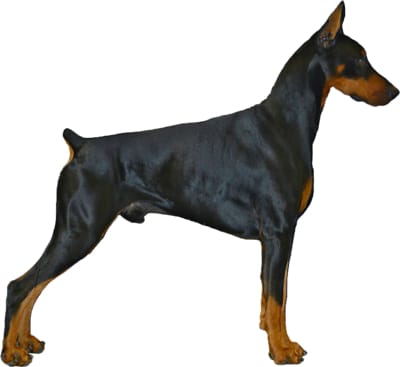
Doberman Pinscher
Overview
Type: Working Dog
Height: 26 – 28 inches (males), 24 – 26 inches (females)
Weight: 75 – 100 lbs (males), 60 – 80 lbs (females)
Price: $1500 – $2500
Lifespan: 10 – 13 Years
Colors: Black, red, blue or fawn (Isabella)
Markings: Light (tan) or dark rust colored—often with a small white patch on the chest.
Physical Traits
Overall Build: Large, tall, compact, and muscular. Toned body with a very smooth, short coat.
Head: Tapering, narrow head with a larger muzzle as compared to head size.
Body: Large, muscular, more wedge-shaped.
Ears: Naturally floppy or cropped (especially in the U.S. & Canada).
Eyes: Light to dark brown. More almond-shaped.
Neck: Longer, rises sharply, and slightly arched.
Chest: Larger, broad chest structure.
Tail: Docked or long, thin, and partially curled.
Legs: Muscular and proportionate.
Feet: Larger cat-like foot structure.
Health Concerns
- Cervical Vertebral Instability (Wobbler Syndrome)
- Chronic Active Hepatitis (CAH)
- Dilated Cardiomyopathy (DCM)
- Gastric Dilatation and Volvulus Syndrome (GDV or Bloat)
- Hip Dysplasia
- Hypothyroidism
- Osteosarcoma (Bone Cancer)
- Progressive Retinal Atrophy (PRA)
- von Willebrand’s Disease (vWD)
Temperament
- Alert, loyal, loving, and protective.
- Less headstrong, dominant, and assertive.
- Even more intelligent.
- Less independent.
- Affectionate and protective of family.
- Loves to cuddle.
- Friendly, but more stoic, disposition.
- Easily bored.
- Prone to separation anxiety.
- Slightly less prey drive.
- Somewhat territorial.
- Not as possessive of toys or food.
- Tolerates small children very well.
- Easy to housebreak.
- Needs routine and exercise.
- Less dog aggressive.
- Curious but pack-oriented—not likely to wander off and explore.
AKC Breed Overview: Doberman Pinscher
Complete Breed Standard: AKC Breed Standard
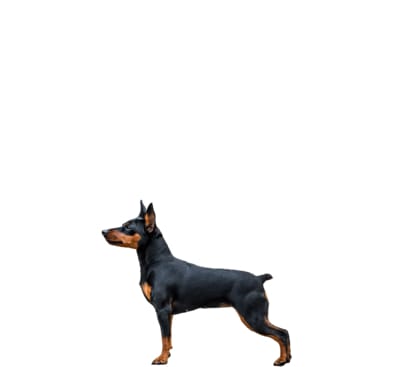
Miniature Pinscher
Overview
Type: Companion (Toy) Dog
Height: 10 – 12.5 inches (males), 10 – 11 inches (females)
Weight: 8 – 10 lbs (males), 8 – 9 lbs (females)
Price: $1300 – $6000
Lifespan: 10 – 16 Years
Colors: Black, red, stag red, or chocolate
Markings: Light (tan) or dark rust colored—often with a small white patch on the chest.
Physical Traits
Overall Build: Small, short, and overall sturdy frame. Toned body with a very smooth, short coat.
Head: Tapering, narrow head with a smaller muzzle as compared to head size.
Body: Compact, muscular, less wedge-shaped.
Ears: Partially floppy, naturally erect, or cropped.
Eyes: Light to dark brown. Overall more round in shape.
Neck: Shorter, rises sharply, and slightly arched.
Chest: Smaller, tighter chest structure.
Tail: Docked or long, thin, and partially curled.
Legs: Muscular and proportionate.
Feet: Smaller cat-like foot structure.
Health Concerns
- Hernias
- Hypothyroidism
- Legg-Perthes Disease
- Lysosomal Storage Disease
- Mucopolysaccharidoses (MPS)
- Patellar Luxation (Loose Knees)
- Progressive Retinal Atrophy (PRA)
Temperament
- Alert, fearless, and fun-loving.
- More headstrong, dominant, and assertive.
- Very intelligent.
- More independent.
- Affectionate and protective of family.
- Loves to cuddle.
- Friendly disposition.
- Easily bored.
- Prone to separation anxiety.
- Strong prey drive.
- Somewhat territorial.
- Possessive of toys or food.
- Doesn’t tolerate small children as well.
- Difficult to housebreak.
- Needs routine and exercise.
- More dog aggressive.
- Curious and adventurous—likely to wander off and explore.
AKC Breed Overview: Miniature Pinscher
Complete Breed Standard: AKC Breed Standard
Did You Know?
There are seven different colors and two main types of Doberman. To learn more, see my article All the Colors and Types of the Doberman Pinscher.
Physical Traits
Similarities
The Doberman and Miniature Pinscher (Min Pin) do have a surprising number of physical similarities, despite their very different genetic origins. They both have toned, compact, muscular bodies and stand with what some call a “proud” posture.
They have a similar short, single layer, smooth coats and as a result, neither dog does well in cold climates. They both have very low grooming requirements and are considered generally clean dogs overall. Neither dog is known to be a big drooler.
Their colors are often similar as well, with similar tan or dark rust-colored markings. They can even both have a small white patch in the center of their chests. However, that’s about where the physical similarities end.
Doberman Pinscher Differences
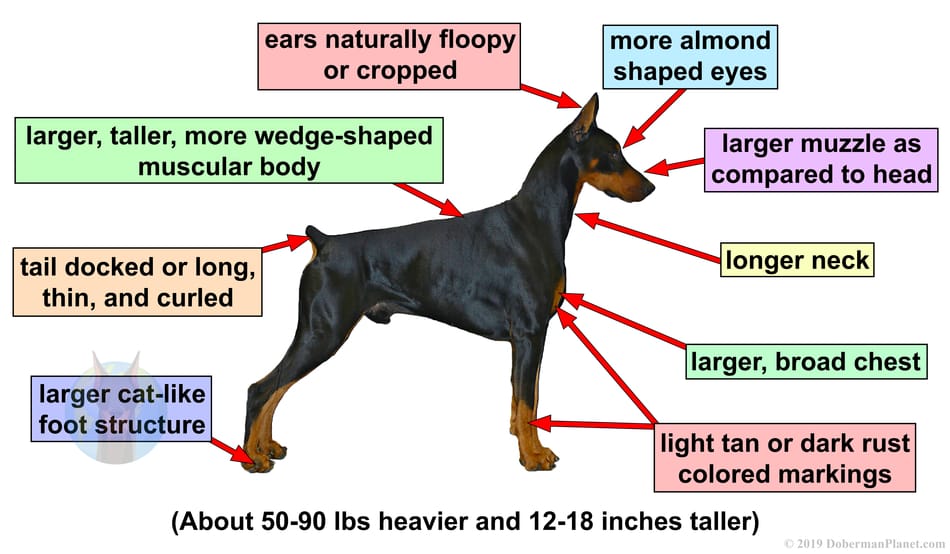
The Doberman Pinscher is a much larger dog, or 50 to 90 pounds heavier and 12 to 18 inches taller, than the Miniature Pinscher. They do have a similar coat in many ways, but they Dobermans tend to shed a bit more than the Miniature Pinschers do.
They have a longer neck to body length ratio, a more wedge-shaped frame, and eyes that are slightly more rounded (depending on the individual dog). They also tend to have a larger muzzle size as compared to their head size than the Miniature Pinscher does. They also have a longer leg to body size ratio.
Miniature Pinscher Differences
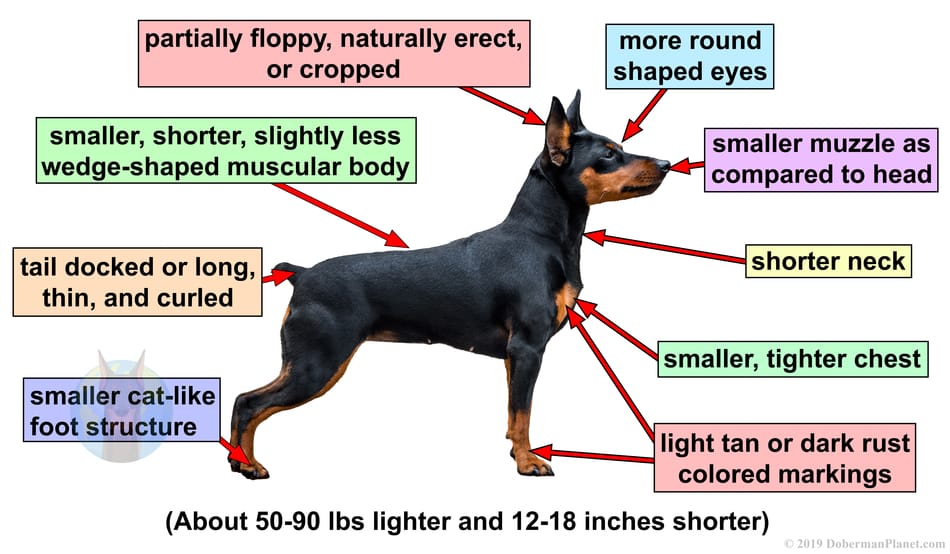
The Miniature Pinscher is a much smaller dog (50 to 90 pounds lighter and 12 to 18 inches shorter). Their coats generally shed less making them require slightly less grooming overall, although both breeds are considered to have low grooming requirements.
The Miniature Pinscher is a sturdy and compact dog, with a very unique high-stepping walk (called a “hackney gait”). Their walk is like no other breed and they appear to naturally “prance” as they walk.
They have a shorter neck to body length ratio, slightly less wedge-shaped frame, and eyes that are usually more round than the Dobermans. They have a smaller muzzle size as compared to their head size and a shorter leg to body ratio.
Temperament
Similarities
Although these two dogs are much more different in their temperament than they are in their looks, they do still have a number of similarities. Both dogs are highly intelligent, proud, and alert dogs that have a reputation for being fearless.
Both the Doberman and Miniature Pinscher are considered very protective of their families and both are extremely affections dogs who are likely to spend their evenings cuddling you on the couch. However, there are many temperamental differences between these two breeds.
Doberman Pinscher Differences
The Doberman Pinscher is part of the working dog class which means they were bred to serve a purpose. In their case, they were bred to be personal protection dogs. They are more in-tune with their owners and have a natural desire to please. They’re also a very tolerant dog that can often take a bit of abuse from over-excited children without reacting harshly. To find out exactly what behavior changes you might see in a Doberman living in a house with kids, see my article Are Dobermans Good with Kids? What You Need to Know.
Dobermans need a bit more exercise than the Miniature Pinscher in order to stay happy and since they are a much larger dog, they require more room to get that exercise. Dobermans are also far easier to train to walk on a leash, and even off of a leash, than a Miniature Pinscher is.
A Doberman will readily listen to their owner’s commands, are more stoic in nature, and love to stick by their owner’s side—especially in new environments.
Miniature Pinscher Differences
The Miniature Pinscher is part of the “toy” class of dogs, which means they are considered companion dogs. Min Pins don’t do very well with young children and if they get too rough, a Min Pin is more likely to nip or bite at the kids. This is due (at least in part) to being smaller and more fragile in size than the Doberman and needing to protect themselves more readily.
Like the Doberman, Miniature Pinschers are energetic dogs who need frequent exercise. However, they’re much smaller so their exercise requirements can be easily fulfilled inside the home. For this reason, many owners who own both breeds feel that their Min Pin is easier to keep happy in terms of their exercise requirements.
Miniature Pinschers tend to be a bit more independent than Dobermans, and love to explore. They may also come across as more headstrong since they won’t always listen to their owner’s attempts to call them back. For this reason, they make poor off-leash dogs and can be difficult to train to walk on a leash as well.
They’re also often called “the king of toys,” referring both to their breed class, and the fact that they love, and are very possessive of, their toys. They can also be a bit more vocal than Dobermans and more frequently have barking issues. They tend to be a bit more dominant with other dogs than Dobermans are.
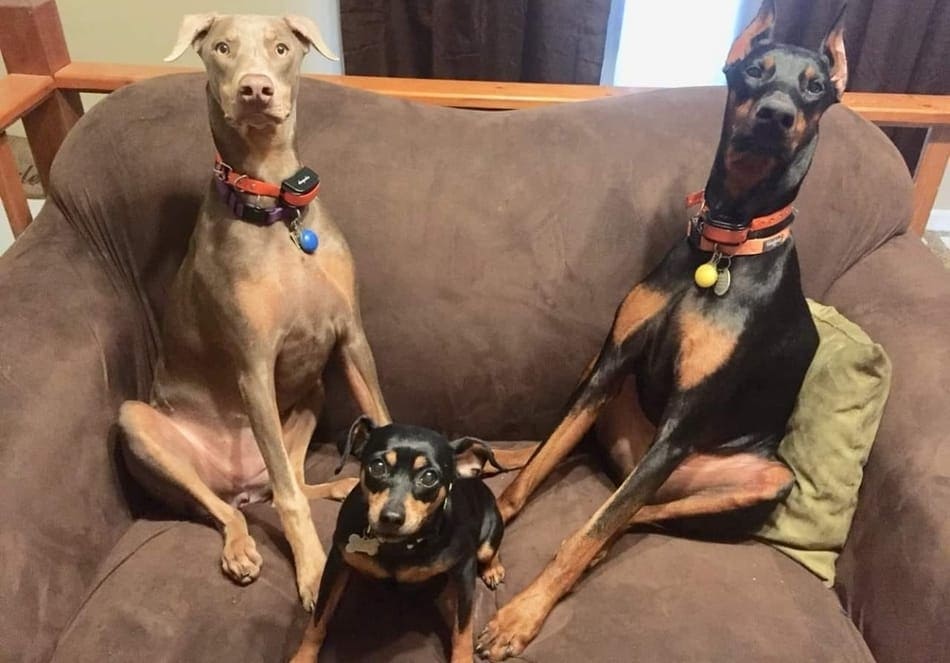
Health Concerns
Similarities
Being both pure-bred dogs, they each have certain health issues that their breed is known to be prone to. However, the Miniature Pinscher is generally considered to have fewer health issues that are of lesser seriousness than Dobermans.
They really don’t have many health issues in common, except for progressive retinal atrophy (PRA) and hypothyroidism—which is common in both breeds. Progressive retinal atrophy causes degeneration of the eye’s retina which leads to progressive vision loss and ultimately it can cause complete blindness.
Hypothyroidism is when there is a problem with how the thyroid gland produces hormones. This can cause weight gain, mental issues, lethargy, and hair loss. A full lifespan is possible with medications though. Other than those two issues in these breeds, the other health problems they’re prone to are very different.
Doberman Pinscher Differences
Dobermans are known to have a few, very serious, health issues. Luckily, many of them can be tested for with genetic testing and this is often done by reputable breeders. Below are some of the health issues common in the Doberman breed.
- Cervical Vertebral Instability (Wobbler Syndrome) – Wobbler syndrome is a genetic disorder that leads to deformations in the spinal cord and neck. Few treatments exist with varying degrees of success.
- Chronic Active Hepatitis (CAH) – Chronic Active Hepatitis is when the liver becomes inflamed and causes scar tissue to form making the liver less effective at filtering the blood. It can be deadly or well managed with medications.
- Dilated Cardiomyopathy (DCM) – Dilated cardiomyopathy is when the heart’s chambers become enlarged and weakened. This causes intolerance to exercise, coughing, lethargy, and ultimately death. This is probably the most significant problem in the Doberman breed, to learn more (including how many Dobermans are affected) see my article Doberman Pinscher Dilated Cardiomyopathy (DCM) Simplified.
- Gastric Dilatation and Volvulus Syndrome (GDV or Bloat) – This condition can occur when the dog eats or drinks too fast or participates in vigorous activities around mealtime. This is when the dog’s stomach twists on itself and cuts off circulation. It can be deadly if not corrected.
- Hip Dysplasia – This is a genetic condition where the hip joint doesn’t form correctly. Dogs with this condition have pain in the hips and lameness issues. This can be well managed with treatment but quality of life will suffer.
- Osteosarcoma (Bone Cancer) – This is a type of cancerous tumor in the bone. It can start slow but then spread quickly throughout the body. This will lead to death in an affected dog.
- von Willebrand’s Disease (vWD) – This issue affects the blood’s ability to clot leading to excessive bleeding. It’s rarely fatal.
Only a few of the above conditions have treatments that will allow a full life span afterward. That is one reason why the Doberman is generally considered to have more significant health issues than the Miniature Pinscher.
Miniature Pinscher Differences
There are certainly a few health issues that affect the Miniature Pinscher, but they tend to be not quite as serious as the Doberman’s issues. Below are some of the common health concerns with the Miniature Pinscher breed.
- Heart Defects – This breed is prone to various heart defects with a wide range of treatment possibilities. Sometimes it’s well managed and other times it’s terminal.
- Hernias – A hernia occurs when the walls of the intestine muscle in the abdomen open and allow contents inside to bulge or pass through. It can cause pain, vomiting, infection, lack of appetite, frequent urination, and blood in the urine. Surgery can correct the issue and a full lifespan can be achieved.
- Legg-Perthes Disease – Also known as “Legg-Calvé-Perthes disease”, this disease has symptoms similar to hip dysplasia. Dogs with this disorder will have difficulty walking, and soreness in the legs and hips. This issue occurs when a blood supply problem causes the head of the femur to stop developing and it doesn’t fit into the hip’s socket as it should. Many treatment options exist but quality of life will be impacted.
- Lysosomal Storage Disease – This usually occurs in puppies and it’s when the body doesn’t produce enzymes which leads to tissue damage and organ failure. It causes development issues, coordination problems, lack of balance, seizures and other problems. This is a fatal disease.
- Mucopolysaccharidoses (MPS) – This is a skeletal development disorder where the body is unable to make certain enzymes that assist in the development of bone. It can result in small size, flat faces, and other skeletal abnormalities. Treatments can prolong the life of an affected dog for several years, although the quality of life during that time is poor.
- Patellar Luxation (Loose Knees) – This disorder causes the dog’s knees to dislocate. It causes discomfort and problems walking. Treatments exist and a full lifespan is achievable although quality of life will suffer.
Though Miniature Pinschers do have their fair share of medical concerns, most professionals believe that they’re somewhat less serious on average, than the Doberman’s are (and with more treatment options).
Genetic Origins
The one thing that both the Doberman and Miniature Pinscher have in common, is that their genetic makeup is not entirely clear. The creator of the Doberman (Louis Dobermann) didn’t keep records as to which breeds he used in the creation of the dog (source).
The Miniature Pinscher, on the other hand, is a much older breed than the Doberman and goes back over 200 years, which is before documentation was kept on breed origins. However, experts of both breeds believe that they have a good idea about which dogs were most likely used in the creation of both breeds.
The only dog both the Doberman Pinscher and Miniature Pinscher likely have in common in their genetic history is the German Pinscher.
Doberman Pinscher Differences
The Doberman Pinscher was originally bred to be a personal guard dog. Although no official documents were kept as to what dogs were used to produce the Doberman, experts believe that the primary breeds used in its creation were likely:
- German pinscher
- Rottweiler
- German shepherd
- Blue great dane
- Greyhound
- Weimaraner
- English greyhound
- Beauceron
- Manchester Terrier
- Shorthaired shepherd
- Black and tan terrier (now extinct)
Miniature Pinscher Differences
The Miniature Pinscher was originally bred to hunt vermin (usually rats) in homes and horse stables. This dog also has somewhat mysterious origins since it outdates this kind of record-keeping (source). However, experts believe that the following dogs were used in its creation:
- German Pinscher
- Dachshund
- Italian Greyhound
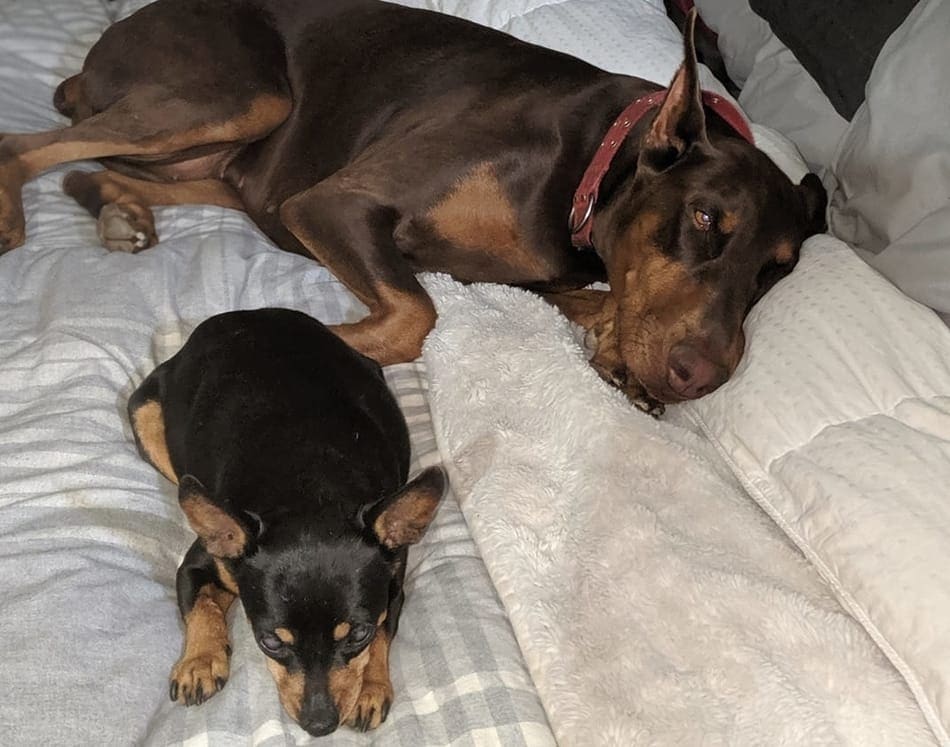
Can a Miniature Pinscher and Doberman Live Together?
After speaking to multiple owners of Dobermans who also have Miniature Pinschers living in their home, I started to see some common threads. Most owners I spoke to said that their Miniature Pinscher was much more dominant towards the Doberman and that the Min Pin was actually “in charge”, or the alpha dog of the house.
Problems can come up when you have two unneutered males in the house, but it is definitely possible for these two dogs to get along. If at all possible, introduce these two dogs when one of them is a puppy. For tips and techniques for making sure they get along, take a look at my article Dobermans Living with Small Dogs: 12 Tips for Success.
Most owners said that they need to be extra cautious to keep the two dogs separated when food is involved (such as at mealtimes). The only other issue that was reported by a few owners was that they need to be cautious that their Doberman doesn’t get overly excited, and rough, during playtime with their Miniature Pinscher. This is due to the size difference and the potential for accidental injuries—not aggression-related injuries.
However, most report very few other issues between these two breeds and say that they are great play-time partners. These two breeds are considered compatible to be living in the same house.
Are Miniature Pinschers Related to Dobermans?
Miniature Pinschers are not considered to be related to Doberman Pinschers. However, it’s believed that they might share one distant relative in common—the German Pinscher. No other genetic relations exist between the two breeds and although they may look similar, other than their size difference, they are actually very different breeds of dog.
Final Thoughts
Both the Doberman Pinscher and the Miniature Pinscher are great dogs that each have their place in a family setting. They can also do great living together in the same household. It’s important to know what you’re getting into if you decide to own one of each of these dogs due to these differences.
Even though these two are very different breeds, your Doberman might just be itching to have a playmate that appears to be his little “mini-me”.
Related Questions
Do Miniature Pinschers make good pets? Miniature Pinschers make great family pets. They are companion dogs who love attention, are fun-loving, and protective of their owners.
What is a mini Doberman? The Miniature Pinscher is often considered to be a miniature version of a Doberman. This is because the Miniature Pinscher is much smaller than the Doberman, but similar in appearance. However, the Miniature Pinscher and Doberman Pinscher are two completely different breeds.

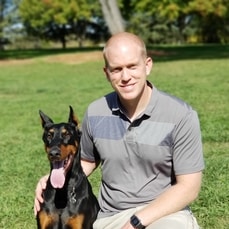

LOL!
I was going to point you to the German Pinscher when I saw the comparison to the Min Pin… But you got there first.
I have owned 5 Dobermans, and right now, 2 German Pinschers. GPs are not for the faint of heart. Smart, exceptionally fast, wake up with a fulll days worth of energy… VERY protective of their territory and family. Not easy to train. They get bored very easily and then watch out!
I’ll train a Dobe anyday!
I wish you had a way to post a photo. The GP looks exactly like a small Dobe… (but they think they are really big dogs.)
My female GP (Pink) lived with my male Dobe for 2 years. He died of DCM just shy of his 5th birthday. (I still miss him. It’s been 6 years!) Pink adored Roo. He was her first love. And he was SO gentle with a little 4 pound puppy.
Dobermans are a wonderful breed!
The mini is not related to doberman at all. The are more related to the terrier family. From research I have reviewed. I think its misleading for anyone to think they make belated at all. The only breed that comes in 3 sizes is the Standard Poodle. Dobermans are not nor have they ever been breed down to create a smaller vision of the breed unlike the Standard poodle.
Hi Debbie, you are definitely correct on that. That’s why I state multiple times in this article that they are not related at all. I compare the two in this article since so many people have asked me how they are similar and what their differences are.